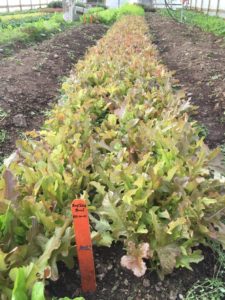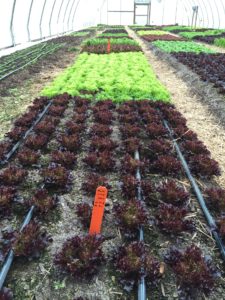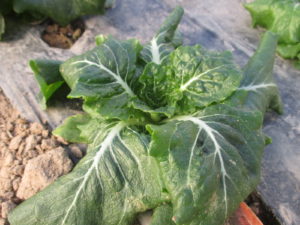Winter farmers markets are becoming more and more popular. Lettuce is a primary type of vegetables grown for the market. As we are finishing up summer crops, it is a good time to learn and refresh knowledge about lettuce. This article discusses some of the basics of growing lettuce in high tunnels, as well as the lessons we learned from a trial conducted at Southwest Purdue Ag Center in fall 2016.
Lettuce Types
Lettuce has multiple morphological forms major types include crisphead (iceberg), butterhead (bibb), romaine (cos), Batavian (summer crisp), and multi-leaf lettuce (salanova). The first decision about growing lettuce is whether to harvest full-size heads of lettuce, or to harvest ‘baby-leaf’ lettuce (Figure 1). These harvest methods require very different production practices. Full-size heads are harvested one time as a single head of leaves. Baby-leaf lettuce is first harvested when single leaves reach about 4 to 5 inches, and then re-cut multiple times in a season as new leaves grow. Harvesting baby-leaf lettuce is more labor intensive. In addition, growing baby-leaf lettuce demands greater care during and after harvest to maintain quality and safety. For harvest of full-size heads, romaine, butterhead, Batavian, and leaf lettuces are good choices for local, protected cultural production. Romaine and leaf lettuces are often grown for baby-leaf lettuce. Multi-leaf types are relatively new and have attracted a lot of attention in recent years (Figure 2). When harvested by cutting just above the growing point, the harvested leaves resemble baby-leaf lettuce. When harvested as entire heads, the end user can easily remove the core to create a mass of lettuce leaves ready for use.
Seed Germination
Germination of lettuce seeds is tricky since they may exhibit different types of dormancy. For example, many lettuce cultivars have varying levels of thermal dormancy that block seed germination when temperatures are above 75 °F. In addition, a few older heirloom cultivars may exhibit photo dormancy, which means they require light to germinate. Germination of these cultivars will be blocked if seeds are buried too deep in the soil. Germination of directly seeded lettuce in high tunnels in early fall may encounter thermal dormancy. From our temperature recordings in a high tunnel at SWPAC in fall 2016, average soil temperatures did not drop below 82 °F until end of September. In this scenario, shade is needed to germinate directly seeded lettuce seeds if they were planted in August and most of the time in September.
Direct Seed or Transplant
Lettuce does not compete well with weeds. Whenever possible, use transplants to ensure a uniform crop. Transplants can be produced in 96 or 128 cell trays. With temperatures between 65 and 75 °F, it normally takes 3-4 weeks to grow transplants. Twelve-inch spacing within and between rows works well for romaine lettuce. Butterhead and leaf lettuce can be planted 6-8’’ within the row and 8-12’’ between the rows. Baby-leaf lettuce is usually direct seeded at very high densities, for instance, 60 seeds per foot in a band several inches wide.
Plant Growth
Optimum daily temperatures for lettuce growth are between 65 to 70 °F, with night temperatures in the range of 45 to 50 °F. Temperatures above 86 °F stunt plant growth, and result in bitterness. Temperatures below 45 °F slow down plant growth considerably. In fall 2016, average temperatures in the high tunnel at SWPAC were above 86 °F until about middle September and did not drop below 45 °F until middle December. Lettuce cultivars ‘Green Forest’, ‘Tropicana’, and ‘Thurinus’ that were planted on Sep 1, Sep 12, Sep 23 and Oct 7 took about 27-30 days from the dates of transplant to the dates of harvest. For seedlings planted on Oct. 21, it took about 42 days for plants to reach the comparable size. Seedlings planted on November 2 were severely damaged by freezing temperatures before they reached marketable size. The majority of the lettuce heads harvested from the trial had great quality, except the heads harvested from the first planting date (Sep 1) that tasted bitter. Our experience with winter production of head lettuce indicates that lettuce seedlings should be planted no later than the end of October in high tunnels in southern Indiana to ensure most growth is completed before temperature drops below 45 °F.
Freezing tolerance
If well hardened, lettuce seedlings can survive temperatures as low as 25 °F. In southern Indiana, maintaining minimal temperatures above 20 °F, in general, can be achieved with a layer of 3 oz/yd. row covers over the top of the beds inside high tunnels. It is, therefore, possible to grow baby-leaf lettuce throughout the winter in a high tunnel without heating. However, as lettuce approaches maturity, it becomes more easily damaged by freezing temperatures (Figure 3). It is less likely that one can grow high-quality head lettuce in winter months without the use of at least minimal heating in southern Indiana.


